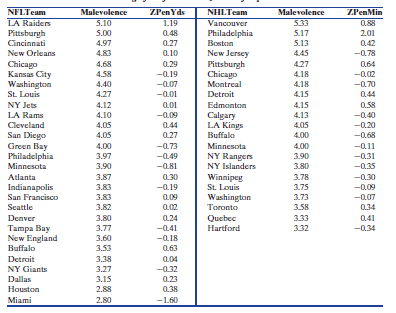Data 4.3 on page 224 describes a study of a possible relationship between the perceived malevolence of
Question:
Data 4.3 on page 224
Frank and Gilovich4 describe a study of relationships between the type of uniforms worn by professional sports teams and the aggressiveness of the team. They consider teams from the National Football League (NFL) and National Hockey League (NHL). Participants with no knowledge of the teams rated the jerseys on characteristics such as timid/aggressive, nice/mean, and good/bad. The averages of these responses produced a €˜€˜malevolence€ index with higher scores signifying impressions of more malevolent (evil-looking) uniforms. To measure aggressiveness, the authors used the amount of penalties (yards for football and minutes for hockey) converted to z-scores and averaged for each team over the seasons from 1970 to 1986. The data are shown in Table 4.1 and stored in MalevolentUniformsNFL and MalevolentUniformsNHL.
Table 4.1

The word "distribution" has several meanings in the financial world, most of them pertaining to the payment of assets from a fund, account, or individual security to an investor or beneficiary. Retirement account distributions are among the most...
Step by Step Answer:

Statistics Unlocking The Power Of Data
ISBN: 9780470601877
1st Edition
Authors: Robin H. Lock, Patti Frazer Lock, Kari Lock Morgan, Eric F. Lock, Dennis F. Lock





